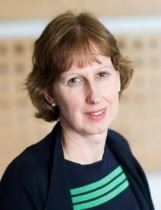On the 12th November 2019 Cathryn Lewis who is Professor of Genetic Epidemiology and Statistics at Kings College London, University of London received her Frank Hansford-Miller Fellowship medal, and led the audience in a tour through some of her research in a talk titled “Polygenic risk scores to predict risk of disease, hype, hope and statistical reality”. Cathryn has been working at her present position for 20 years and describes herself as someone who works on applied statistics. This is very fitting as Frank was very enthusiastic for applied statistics and the benefit that it could bring to the whole of society. Cathryn trained as a mathematical statistician, receiving a BA from Oxford, then a Masters and PhD from the University of Sheffield, before moving to do a postdoctoral work at the University of Utah, Salt Lake City, USA. Here she was involved with discovering the link between the BRCA1 gene and the risk of breast cancer, which has motivated a lot of interest in genetics and risk ever since. She returned to England taking up her current position which she has worked at apart from short sojourns off for having children.
 Cathryn noted that while she was in London reading about Frank she was struck by the quote “He was a rather eccentric Englishman who adopted Australia as his home after he retired from the UK”. On arriving in Perth, she could now see exactly why he had done this and volunteered to say that if we have any tutorial posts in 10 years time she would certainly be interested.
Cathryn noted that while she was in London reading about Frank she was struck by the quote “He was a rather eccentric Englishman who adopted Australia as his home after he retired from the UK”. On arriving in Perth, she could now see exactly why he had done this and volunteered to say that if we have any tutorial posts in 10 years time she would certainly be interested.
The synopsis of Cathryn Lewis’ talk started with an introduction to genetics and polygenic risk scores, analysis methods, challenges, and a return to quote Frank Hansford-Miller.
She introduced the discovery of DNA and highlighted the work of Rosalyn Franklin, somewhat overlooked when discussing the discovery of DNA in 1953 by Crick and Watson.
She then talked about why a statistician may be interested in DNA by alluding to the fact that there were 3 billion base pairs in the DNA which would take us 50 years to type out one letter at a time, but pointed out there were 0.1 % of these pairs distinguished us as individuals. While 0.1% is small this percentage of 3 billion is quite an amount of data. She went on to discuss the link or hypothesis that various alleles could lead to increased risk of disorders such as depression. The genetics technology now looks at sites across half a million sites at one time examining the whole genome at one time. There are matrices of data, and each row is examined at one row at a time, and individuals are examined for cases and controls. There are adjustments for ancestry. Essentially for each SNP a logistic regression is carried out so that one gets an odds ratio for a particular increased risk of a particular allele. The studies involve P-values which are adjusted for the large numbers of tests carried out.
In comparison to other disorders “hits” due to particular gene types only began for depression in 2015. Risks on a polygenic scale now lead to risk scores for every individual that give you information on risk of the disorder. Methods involve weighted scores across all SNP’s.. There are considerations of correlation and independence
Results involve scores that have roughly a normal distribution, and then interest is in the tails.
How do we predict outcomes for cases and controls?
We were led through various statistical methodologies of Cohen’s D and Nagelkerke’s R.
Depression has a prevalence disorder of 15%. Some discussion ensued about course of illness.
A discussion of risk in other areas put the ideas of screening for various disorders in perspective, and it was pointed out that predictions of disorder were not the same for African as opposed to European cases whereupon ancestry is important.
There is still a need to increase the predictive ability. We have gone from a yes/no genetic description to a polygenic risk on a normal scale.
To remind us of the aptness of her work Cathryn pointed to a quote from
Frank “We have been become too technical and should ask “How is this piece or research going to help humanity””
and challenged us all to play a part in making statistics relevant to society. She closed her talk with a picture of the double helix in the DNA tower at Kings Park.
Brenton R Clarke


